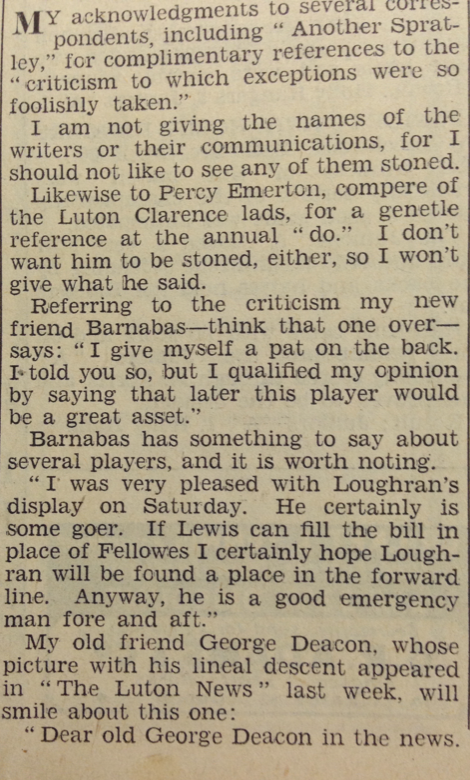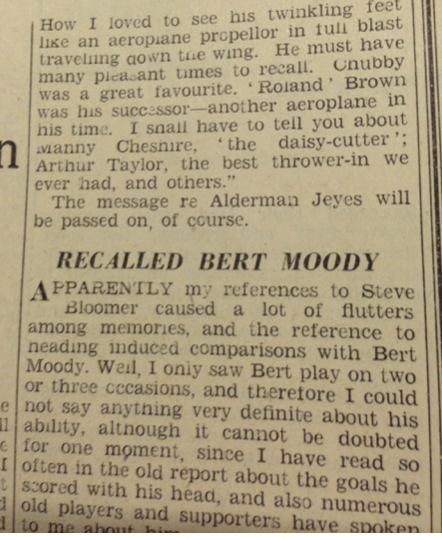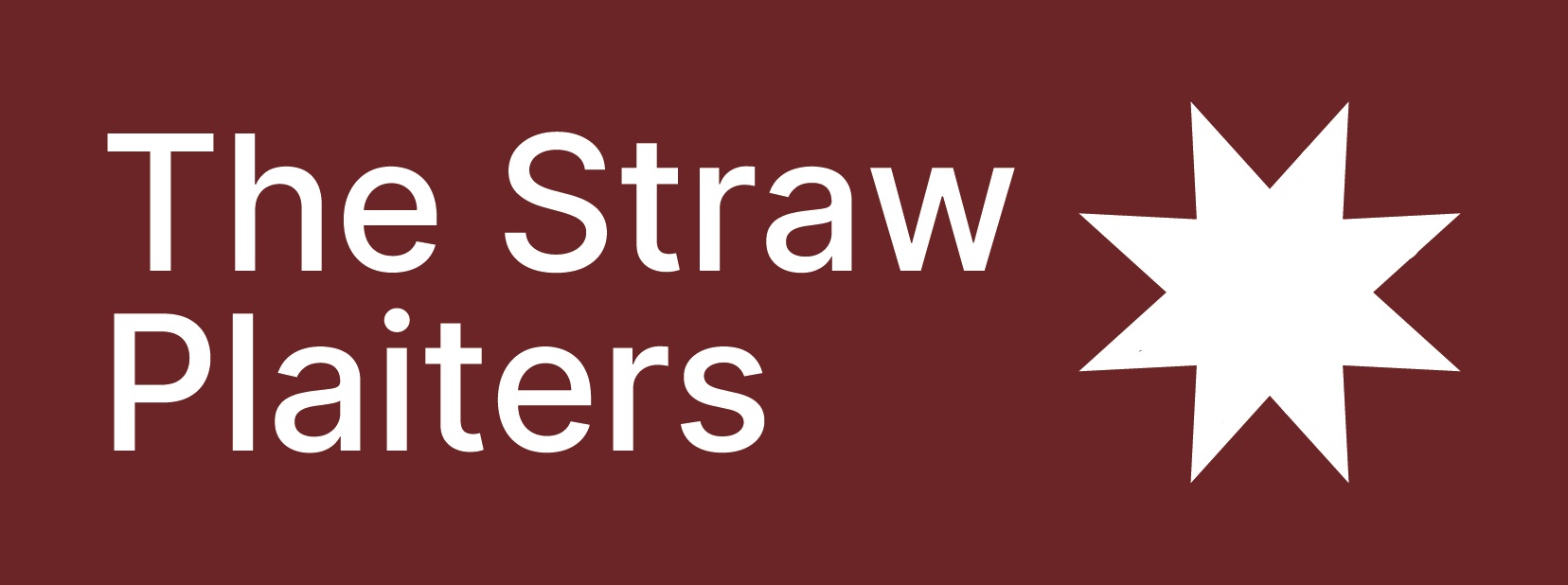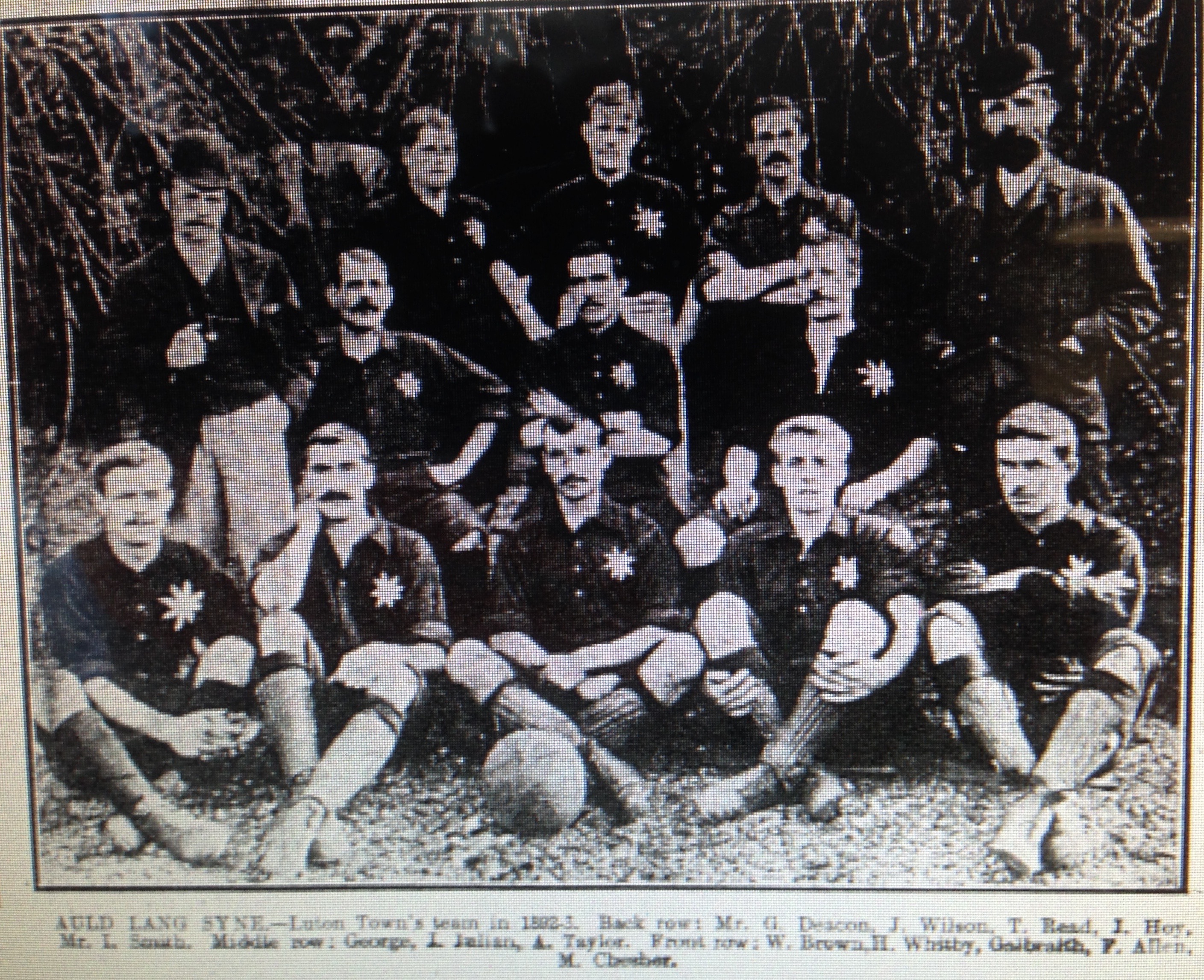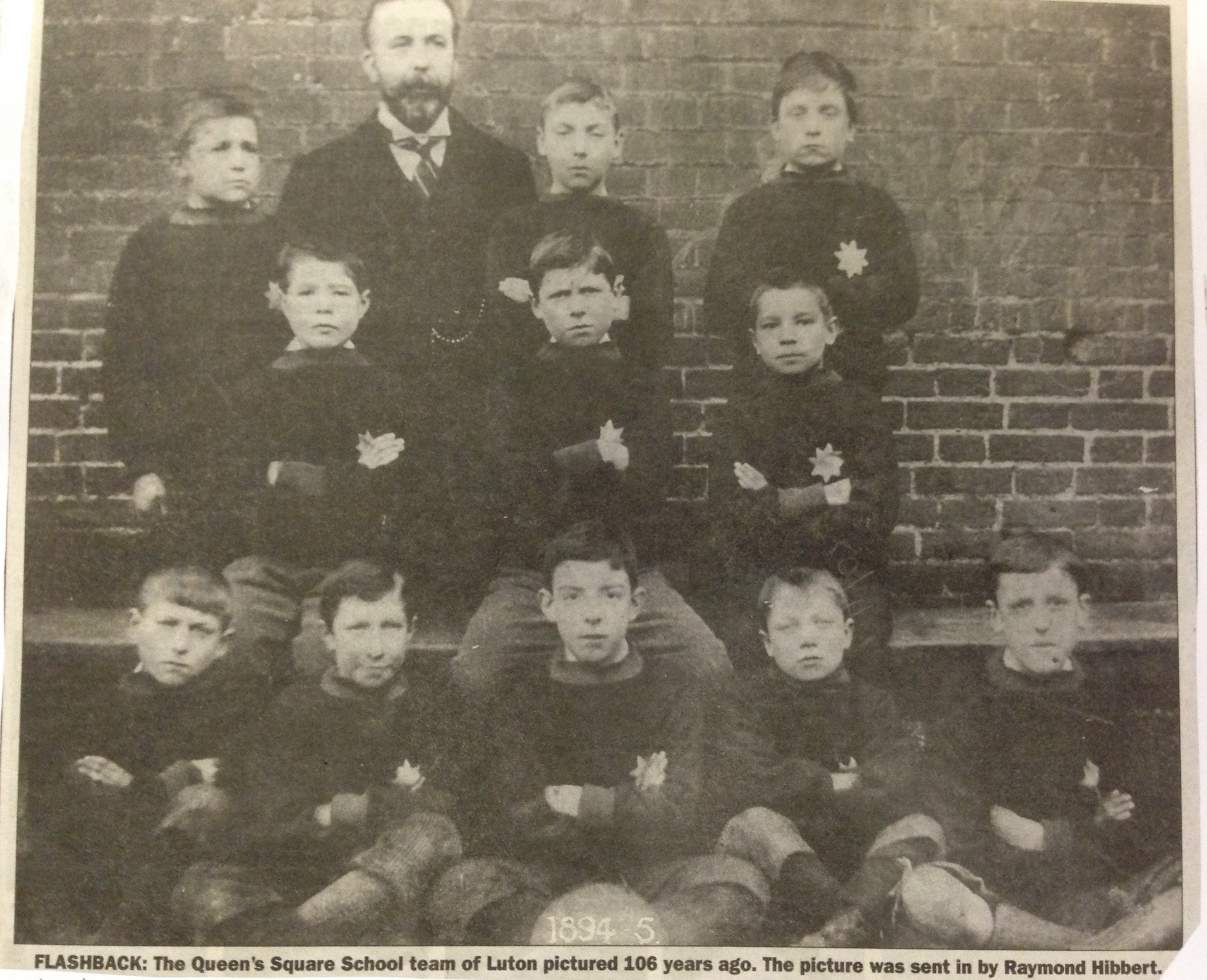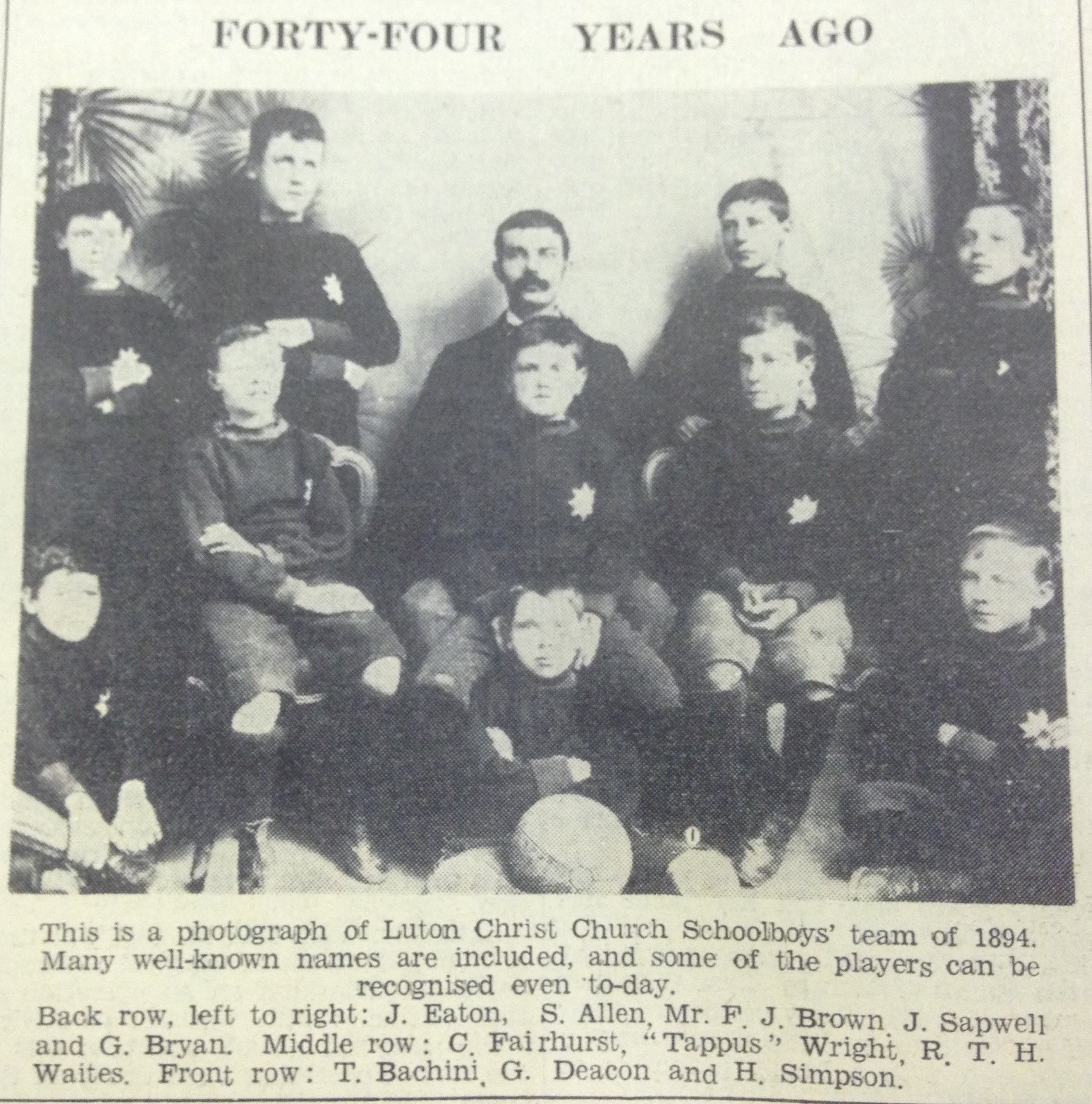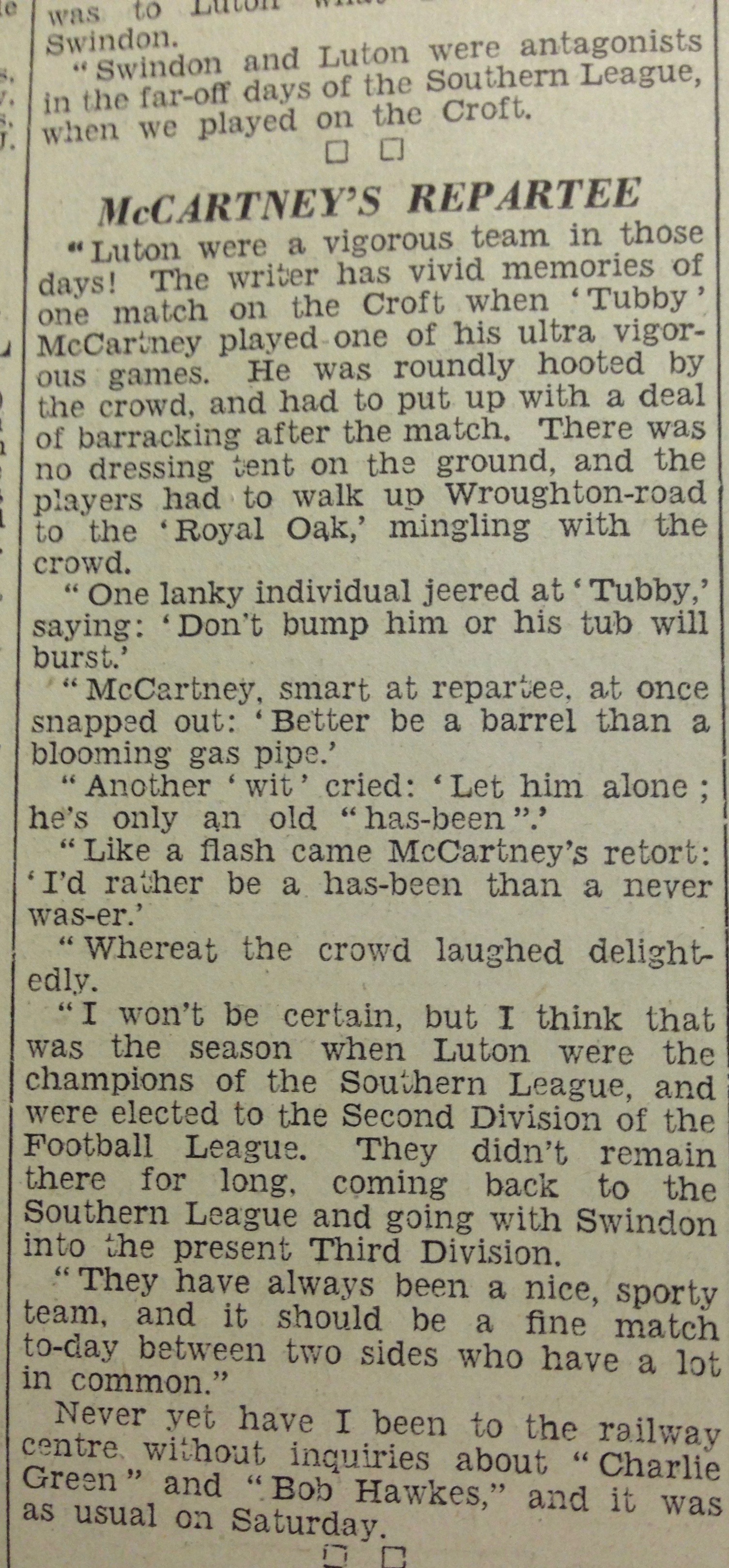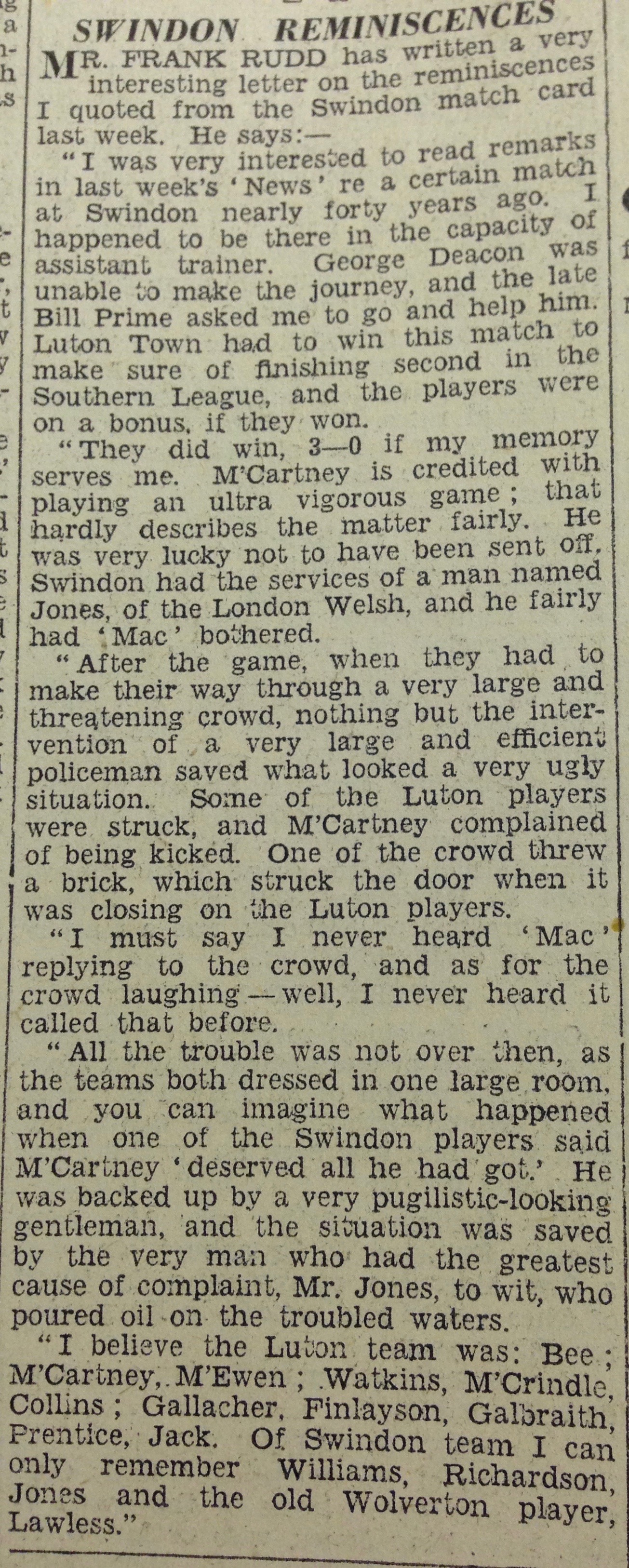Looking back – Newspaper reports
This section contains 1920’s and 30’s newspaper reports about football in Luton in the Victorian era. They can be useful in providing some personal information about the period which is invaluable. They must, however, be viewed with caution. Memories fade and some details are innocently skewed. Other clips are more sinister, such as Frank Whitby’s claim in 1936 that he was the first to sign professional terms with Luton Town, and therefore was the first professional footballer in the South of England. He conveniently forgot two other players who signed before him including his own brother, Harry. This first clip from 1926 confirms my findings – which I arrived at before seeing this clip.
From the Luton News 25th February 1926
“There was football of a kind in Luton fifty years ago, but it is extremely doubtful whether there exists records of any club precent to Luton Wanderers. Concurrently with the Wanderers there were several clubs, but only the Excelsior had any pretensions to equal strength, and the fusion of these clubs was the birth of Luton Town Football Club.”
The Wanderers’ Club was formed in September, 1880, at a meeting held at the “Cricketer’s Arms,” High Town-road. Its members were all working men, and paid a shilling entrance fee, and a subscription of twopence per week for the season. The first secretary was Mr J.H. Bennett, happily still with us, though he has passed the allotted span. Mr H.G. Spratley was the assistant secretary, and the affairs of the club were managed by a committee of five. The first playing members were T. Brooks, George Deacon, Albert Deacon, B. Barrett, J. Odell, George Smith, T. Veal, G. Abbott, W.H. Wheeler, Geo. Bennett, G. Clark and R. Ellingham. Messrs Odell, Wheeler and Veal have passed away, but the others, and several members of the Club, still survive.
They played on Bell Close, People’s Park, and so there was no gate money taken. The ground was used until 1884, when a meadow belonging to Mr W. Deacon, of Dallow-road, was hired. On this field, now the West Ward Recreation, was played the first F.A. Cup Tie decided in Luton. The Old Etonians, then a big power in football, visited and defeated the Wanderers by three goals to one.
The Club made good progress, and a stroke of fortune was the arrival of the three brothers Lomax at St. John’s College, New Bedford-road. The headmaster was Mr Wright, and Charles, Ernest and Dan Lomax, E. Wright, son of the headmaster, J. Ross, C. Narburg, and several others threw in their lot with the Wanderers.
The Excelsior were a strong combination, too, and on 11th April 1885, there was a meeting of the two clubs, with the result that Mr G.H. Small, of the Excelsior moved, and Mr Ernest H. Lomax seconded a resolution that “The Luton Town Club be formed.” This was carried.
According to Mr Charles Green’s records the first secretary was Mr F. Pitkin, and his assistant, Mr P.A. Findlay. The committee comprised Messrs G. Furlong, J. Long, G.H. Small, S. Pakes, T. Brookes, C. Abbott, T.C. Brown, H.G. Spratley and G. Deacon. The colours were navy blue and pink halves for shirts and caps, and the resolution read that both cap and shirt be worn by each player on the field.
The first ground was the Excelsior pitch, now the timber yard of Messrs. Henry Brown and Son, and this was in use for twelve years. At the general meeting in 1886, Mr Pitkin retired from the secretarial office, although he continued for many years on the Committee, and Mr Isaac Smith, who had been a player, was chosen as secretary, with Mr W.G. Wheeler as assistant. They remained in office until 1896. Mr Smith did not relinquish his interest, for he subsequently became a director.
During the second season three of the players were given the proceeds of a match, this being the first record in the South of players being paid for their services. In 1889 the club colours were changed to cochineal, and they became known as “the Reds.”
In the following season payment of players was officially recognised, for on December 13th, 1890, the sum of 5s per week was offered to F. Whitby, H. Whitby and T. Read. H. Whitby accepted the offer, and it is generally believed that he was the first professional player in the South.
At the general meeting afterwards it was decided to pay the whole of the team, and on August 10th, 1891, committee and players met, a member of the committee moved, and a player seconded, a resolution that players be allowed 2s 6d per week, with an extra 6d per week for away matches, and that they should be paid for all lost time before 12 noon. This first professional team was : Burley; Sanders, Hoy; Taylor, Paul, Wright; F. and H. Whitby, Deacon, Chesher, Oclee. Taylor was the captain, and all but he and Paul and Oclee were Luton natives.
The following season the wages were doubled, and in addition Julian, who had been playing for Woolwich Arsenal, was secured and paid a much higher fee. By May, 1893, the club was a real power in the South, for they defeated Old Westminsters at Wemblery Park in an F.A. Cup Tie, although the latter had six international players in their team. In the next round, however, Luton lost to Middlesbrough Ironopolis by 2-1.
In 1894-95 Luton helped form the Southern League, and played that and the following season in the competition, but in 1896 endeavoured to join the Second Division of the League. They failed, but left the Southern League and played in a strong combination known as the United League.
On June 11th, 1897, the annual meeting decided to make the club a limited company and this came about on October 27th, 1897.”
———————————————————————–
From the Pictorial 20th September 1932, this photo shows the 1895/96 team. It is one of only two known photographs of the Dallow Lane ground.
—————————————————————
From the Luton News 1st February 1934
President of LTFC Alderman Harry Arnold (committee member in 1893) presided at the Annual General Meeting. Isaac Smith was a guest.
“He recalled the fact that the Town embraced professionalism as long ago as 1891, so they would recognise the great changes that had taken place in the game during the forty two years. He himself had experienced all the phases of football, his memory going back to what was known as the Sheffield offside rule, and during those years the conduct of the Town Club had reflected the spirit behind the movement of professionalism in Luton. He paid tribute to the memory of those who held the reigns of office in the early days, as well as to those which had succeeded, and had brought the club to its present position in the interests of the town and country generally – (applause).
“Mr A. J. Mander then made reference to the cup-tie against Middlesbrough Ironopolis forty years ago last Saturday, and recalled that those were the days when the ground was on the site now occupied by Brown’s timber yard. He caused laughter by saying that he and his brother, Mr Fred Mander, with other small boys watched the games from the footpath by the side of the railway, and this enabled him to turn the point of the story by complimenting the Club on their generosity and foresight in admitting a large number of boys free to the games every Saturday…”
The President said that when he entered the room someone asked him how long he had been associated with the Club and its management, and he could not immediately reply. They had been told it was forty-one years since the club adopted professionalism, and he thought even now there were some who did not know how it came about. Owing to the fact that few matches were started at the advertised time of kick-off the committee decided to pay some of the players – some of them did not want to become professionals – the princely sum of 2s per week, and that was the origin of professionalism in Luton. They had seen it stated from time to time that the Arsenal was the first professional Club in the South of England, but that was not so: Luton was first.
Alderman Arnold said that he had another reminder in the “Saturday Telegraph” when he read of the match with Middlesbrough Ironopolis. He remembered the game perfectly well and he had never seen a game played under such tempestuous conditions. Unfortunately Luton lost the toss and had to play in the teeth of a gale which was so strong that often the ball was blown out of play at the other end when kicked off from one goal. At half-time they thought they had a chance but the Luton team had suffered so much when facing the gale that they could not raise a gallop in the second half, and were beaten by the odd goal”.
“The President recalled the formation of the Club by the amalgamation of the Wanderers and the Excelsior clubs, and had vivid recollections of the meeting, but was not quite sure whether it was twelve months before or twelve months after that he joined the committee, but it was forty three or forty four years ago. He had the privilege of being Chairman of the Town Club for something like forty years, and one of his keenest friends and colleagues was Mr Ernest Gibbs, who joined two or three years later – (applause).
“Sir Thomas Keens proposed “The Directors” and evoked some surprise when he recalled that he was present at the meeting when the Town Club was formed, and that he had vivid recollections of the eloquence of a gentleman from North-street, who harangued the rest on the wrongs of one club, and he had to be placated before they could get the Town Club – (laughter).”
Note – The Association Rules of 1867 gave offside when there were less than 3 players between the goal and the player receiving the ball. The Sheffield Association only obliged one player to be between the players and the goal to prevent off-side. The Sheffield Association played this rule for ten years before they succumbed to the Association. From Montague Shearman, Athletics and Football 1887
———————————————————–
From the Beds and Herts Pictorial of 13th September 1927. I rediscovered this photo in July 2015 when looking through the Pictorial microfilm – hence the poor quality. The search is on for the original negative. From the team line up and specific mentions in the Luton Reporter, we can date this photograph to either 15th April 1893 (before the game against Royal Arsenal) or the 28th April 1893 (before the game against Mr Rostron Bourke’s eleven, which were a representative London team). The photo was taken at the Dallow Lane ground. This photograph bridges the gap between the 1891/92 season photo and the 1893/94 photo.
The legendary George Deacon had retired in April 1892 and was paid 1/- (one shilling) a week to act as “attendant.”
Note the different sized stars on the players shirts. Some are large and appear home made and others are of a regular size and look professionally made. The photos below are from the Luton News and shows that schoolchildren emulated their local heroes – see the stars on their football shirts.
—————————————————————-
Queen’s Square School, New Town Street, in their 1894/95 football kit. Photo courtesy of the Luton News.
Christ Church School also copied their heroes as shown in the photo below taken from the 1st December 1938 Luton News.
——————————————————————————–
The following two clips demonstrate the perils of relying on memories many years later. The first is from the Luton News of the 21st February 1935 and talks of good humour at a game with Swindon. The following week came a letter from a correspondent with the opposite recollection. The Croft was Swindon’s ground.
The two clips below are from the Luton News of the 13th April 1939.
